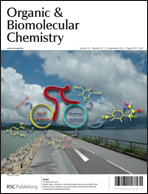O4-Alkyl-2′-deoxythymidine cross-linked DNA to probe recognition and repair by O6-alkylguanine DNA alkyltransferases†‡
Abstract
DNA duplexes containing a directly opposed O4-2′-deoxythymidine-alkyl-O4-2′-deoxythymidine (O4-dT-alkyl-O4-dT) interstrand cross-link (ICL) have been prepared by the synthesis of cross-linked nucleoside dimers which were converted to phosphoramidites to produce site specific ICL. ICL duplexes containing alkyl chains of four and seven methylene groups were prepared and characterized by mass spectrometry and nuclease digests. Thermal denaturation experiments revealed four and seven methylene containing ICL increased the Tm of the duplex with respect to the non-cross-linked control with an observed decrease in enthalpy based on thermodynamic analysis of the denaturation curves. Circular dichroism experiments on the ICL duplexes indicated minimal difference from B-form DNA structure. These ICL were used for DNA repair studies with O6-alkylguanine DNA alkyltransferase (AGT) proteins from human (hAGT) and E. coli (Ada-C and OGT), whose purpose is to remove O6-alkylguanine and in some cases O4-alkylthymine lesions. It has been previously shown that hAGT can repair O6-2′-deoxyguanosine-alkyl-O6-2′-deoxyguanosine ICL. The O4-dT-alkyl-O4-dT ICL prepared in this study were found to evade repair by hAGT, OGT and Ada-C. Electromobility shift assay (EMSA) results indicated that the absence of any repair by hAGT was not a result of binding. OGT was the only AGT to show activity in the repair of oligonucleotides containing the mono-adducts O4-butyl-4-ol-2′-deoxythymidine and O4-heptyl-7-ol-2′-deoxythymidine. Binding experiments conducted with hAGT demonstrated that the protein bound O4-alkylthymine lesions with similar affinities to O6-methylguanine, which hAGT repairs efficiently, suggesting the lack of O4-alkylthymine repair by hAGT is not a function of recognition.

- This article is part of the themed collection: Nucleic acids: new life, new materials

 Please wait while we load your content...
Please wait while we load your content...